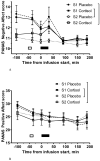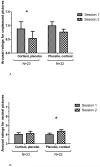The effect of cortisol on emotional responses depends on order of cortisol and placebo administration in a within-subject design
- PMID: 21232874
- PMCID: PMC3110569
- DOI: 10.1016/j.psyneuen.2010.11.010
The effect of cortisol on emotional responses depends on order of cortisol and placebo administration in a within-subject design
Abstract
Cortisol does not exhibit a straightforward relationship with mood states; administration of glucocorticoids to human subjects has produced mixed effects on mood and emotional processing. In this study, participants (N=46) received intravenous hydrocortisone (synthetic cortisol; 0.1mg/kg body weight) and placebo in randomized order over two sessions 48h apart. Following the infusion, participants rated neutral and unpleasant pictures. In Session 1, participants reported elevated negative affect (NA) following the picture-rating task, regardless of treatment. In Session 2, however, only participants who received cortisol (and thus who had received placebo in Session 1) reported elevated NA. Arousal ratings for unpleasant pictures followed a similar pattern. These findings suggest that the effects of cortisol on emotion vary based on situational factors, such as drug administration order or familiarity with the tasks and setting. Such factors can influence cortisol's effects on emotion in two ways: (A) cortisol may only potentiate NA and arousal ratings in the absence of other, overwhelming influences on affect, such as the novelty of the setting and tasks in Session 1; and (B) cortisol in Session 1 may facilitate learning processes (e.g., habituation to the stimuli and setting; extinction of aversive responses) such that emotional responses to the pictures are lessened in Session 2. This interpretation is compatible with a body of literature on the effects of glucocorticoids on learning and memory processes.
Copyright © 2010 Elsevier Ltd. All rights reserved.
Figures





Comment in
-
Re: "The effect of cortisol on emotional responses depends on order of cortisol and placebo administration in a within-subject design" by Wirth et al.Psychoneuroendocrinology. 2011 Aug;36(7):1097-8; author reply 1098-9. doi: 10.1016/j.psyneuen.2011.03.021. Epub 2011 May 6. Psychoneuroendocrinology. 2011. PMID: 21530091 No abstract available.
Similar articles
-
Inter-individual differences in trait negative affect moderate cortisol's effects on memory formation: preliminary findings from two studies.Psychoneuroendocrinology. 2012 May;37(5):693-701. doi: 10.1016/j.psyneuen.2011.08.014. Epub 2011 Sep 28. Psychoneuroendocrinology. 2012. PMID: 21955834 Free PMC article. Clinical Trial.
-
The effect of exogenous cortisol during sleep on the behavioral and neural correlates of emotional memory consolidation in humans.Psychoneuroendocrinology. 2013 Sep;38(9):1639-49. doi: 10.1016/j.psyneuen.2013.01.009. Epub 2013 Feb 26. Psychoneuroendocrinology. 2013. PMID: 23484632 Clinical Trial.
-
Time-dependent effects of cortisol on the contextualization of emotional memories.Biol Psychiatry. 2013 Dec 1;74(11):809-16. doi: 10.1016/j.biopsych.2013.06.022. Epub 2013 Aug 20. Biol Psychiatry. 2013. PMID: 23972529 Clinical Trial.
-
Acute cortisol elevations cause heightened arousal ratings of objectively nonarousing stimuli.Emotion. 2005 Sep;5(3):354-9. doi: 10.1037/1528-3542.5.3.354. Emotion. 2005. PMID: 16187871 Clinical Trial.
-
Modulatory mechanisms of cortisol effects on emotional learning and memory: novel perspectives.Psychoneuroendocrinology. 2013 Sep;38(9):1874-82. doi: 10.1016/j.psyneuen.2013.06.012. Epub 2013 Jul 8. Psychoneuroendocrinology. 2013. PMID: 23845515 Free PMC article. Review.
Cited by
-
Neurophysiological Processing of an Emotional Task is Sensitive to Time-of-Day.J Circadian Rhythms. 2017 May 23;15:4. doi: 10.5334/jcr.148. J Circadian Rhythms. 2017. PMID: 30210558 Free PMC article.
-
Indigenous Land-Based Approaches to Well-Being: The Niska (Goose) Harvesting Program in Subarctic Ontario, Canada.Int J Environ Res Public Health. 2023 Feb 19;20(4):3686. doi: 10.3390/ijerph20043686. Int J Environ Res Public Health. 2023. PMID: 36834382 Free PMC article.
-
Recommendations and evidence for reporting items in pediatric clinical trial protocols and reports: two systematic reviews.Trials. 2015 Sep 18;16:417. doi: 10.1186/s13063-015-0954-0. Trials. 2015. PMID: 26385379 Free PMC article.
-
Indigenous Land-Based Approaches to Well-Being: The Amisk (Beaver) Harvesting Program in Subarctic Ontario, Canada.Int J Environ Res Public Health. 2022 Jun 15;19(12):7335. doi: 10.3390/ijerph19127335. Int J Environ Res Public Health. 2022. PMID: 35742603 Free PMC article.
-
Circulating cortisol levels after exogenous cortisol administration are higher in women using hormonal contraceptives: data from two preliminary studies.Stress. 2014 Jul;17(4):314-20. doi: 10.3109/10253890.2014.919447. Stress. 2014. PMID: 24773147 Free PMC article.
References
-
- Abelson JL, Khan S, Liberzon I, Young EA. HPA axis activity in patients with panic disorder: Review and synthesis of four studies. Depression and Anxiety. 2007;24(1):66–76. - PubMed
-
- Abercrombie HC, Kalin NH, Thurow ME, Rosenkranz MA, Davidson RJ. Cortisol variation in humans affects memory for emotionally laden and neutral information. Behav. Neurosci. 2003;117(3):505–16. - PubMed
-
- Abercrombie HC, Kalin NH, Davidson RJ. Acute cortisol elevations cause heightened arousal ratings of objectively nonarousing stimuli. Emotion. 2005;5(3):354–9. - PubMed
-
- Abercrombie HC, Speck NS, Monticelli RM. Endogenous cortisol elevations are related to memory facilitation only in individuals who are emotionally aroused. Psychoneuroendocrinology. 2006;31(2):187–96. - PubMed
-
- Bradley MM, Codispoti M, Cuthbert BN, Lang PJ. Emotion and motivation I: Defensive and appetitive reactions in picture processing. Emotion. 2001;1(3):276–98. - PubMed
Publication types
MeSH terms
Substances
Grants and funding
LinkOut - more resources
Full Text Sources

